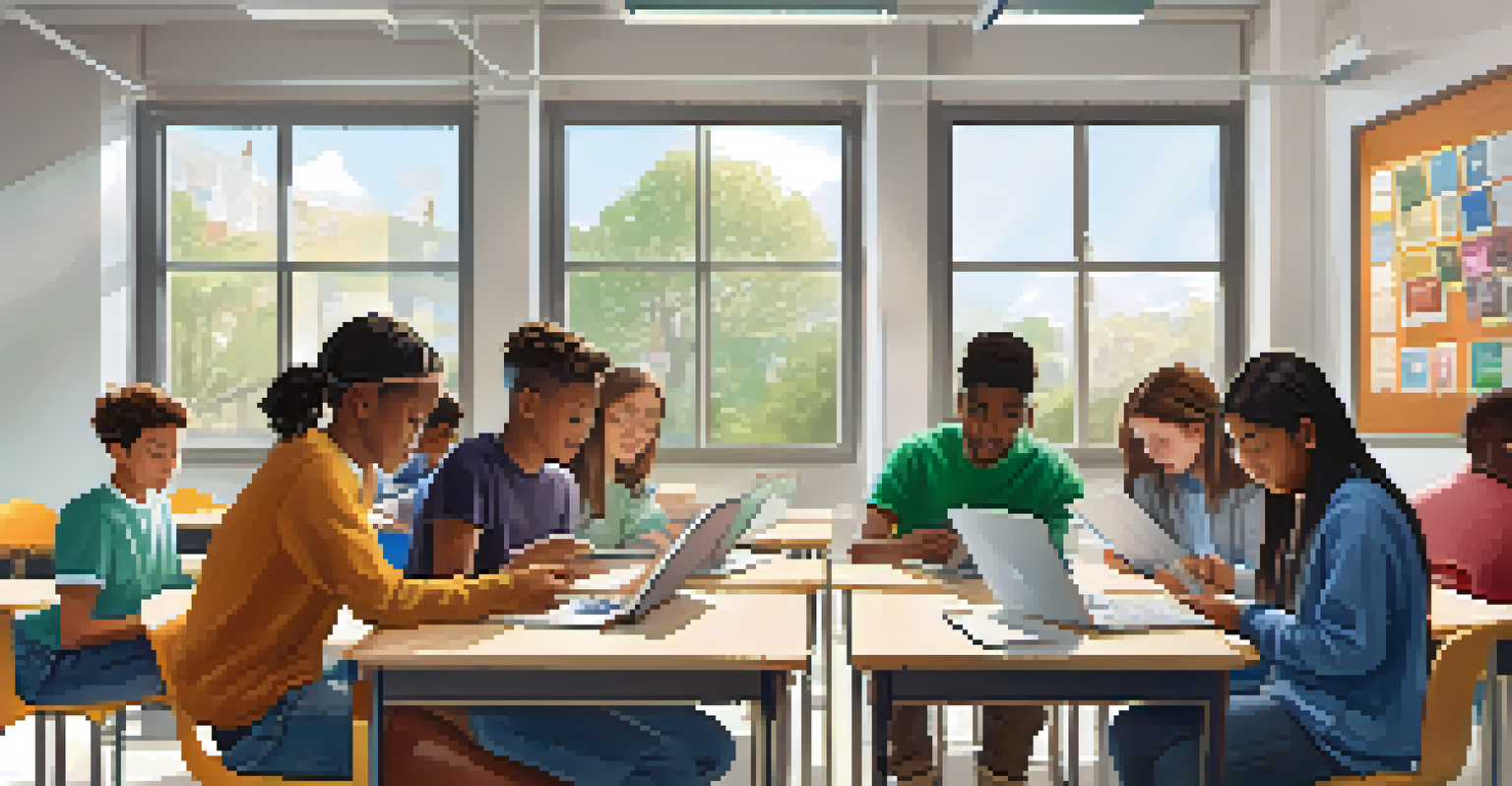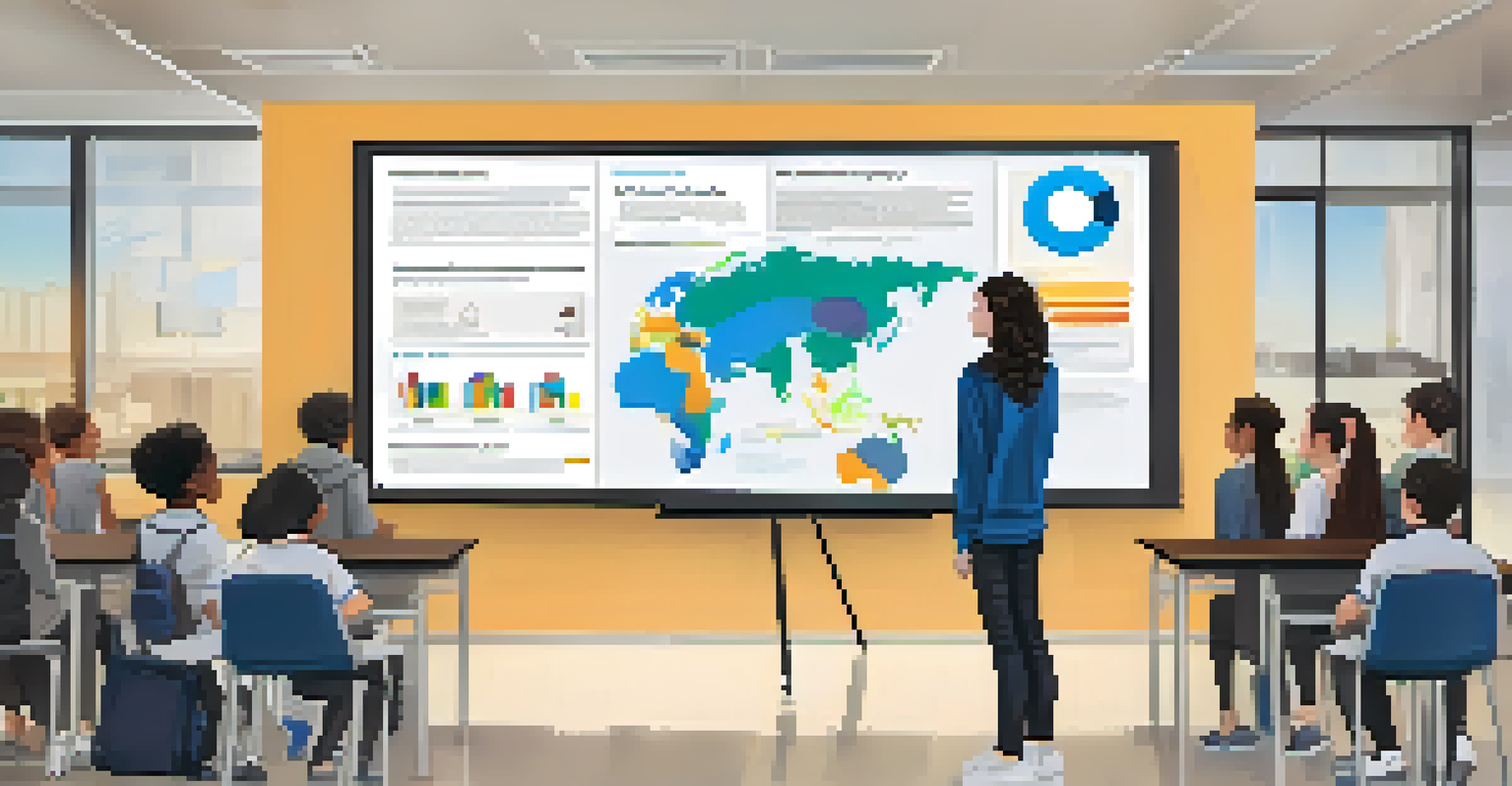The Influence of Digital Portfolios on Student Motivation

Understanding Digital Portfolios in Education
Digital portfolios are collections of a student's work, showcasing their skills and achievements over time. They can include various media, such as videos, essays, and projects, allowing for a more dynamic representation of learning. This format contrasts with traditional portfolios, which are often paper-based and can feel static or limited in scope.
Education is not the filling of a pail, but the lighting of a fire.
By integrating technology into the portfolio process, educators can enhance accessibility and interactivity for students. Digital portfolios encourage students to reflect on their learning journeys, making it easier for them to track their progress. This reflection is key to personal growth and helps students recognize their strengths and areas for improvement.
In essence, digital portfolios offer a more comprehensive view of a student's learning experience, fostering a sense of ownership and pride in their accomplishments. As we delve deeper into this topic, we'll explore how these portfolios can significantly influence student motivation.
Boosting Student Ownership and Accountability
One of the greatest benefits of digital portfolios is that they empower students to take ownership of their learning. When students curate their work, they become more invested in their educational journey. This sense of ownership naturally leads to increased accountability, as students want to showcase their best efforts.

For example, a student who knows they will present their digital portfolio to peers or teachers may strive harder to produce quality work. This accountability encourages them to set goals and work towards achieving them. In turn, the process of collecting and reflecting on their work can motivate students to push their boundaries and explore new interests.
Empowering Student Ownership
Digital portfolios encourage students to take ownership of their learning, fostering accountability and motivation.
Ultimately, the sense of ownership and accountability fostered by digital portfolios can lead to a more engaged and motivated learner. As students see their progress and achievements documented, they gain confidence in their abilities, further fueling their desire to succeed.
Enhancing Reflection and Self-Assessment Skills
Digital portfolios provide an excellent platform for students to engage in self-reflection and assessment. By regularly reviewing their work, students can identify patterns in their learning and recognize areas that need improvement. This practice not only helps them develop critical thinking skills but also nurtures a growth mindset.
Digital learning is not about technology; it's about the people using it.
When students reflect on their successes and challenges, they learn to appreciate the learning process itself. For instance, a student might realize that their writing improved over the semester by comparing earlier drafts to their final pieces. This recognition can be incredibly motivating, as it highlights their progress and reinforces the idea that effort leads to growth.
Moreover, self-assessment encourages students to set personal goals based on their reflections. By fostering a habit of reflection, digital portfolios can help students become more self-aware and proactive in their learning journeys.
Facilitating Peer Feedback and Collaboration
Digital portfolios not only allow for individual expression but also facilitate peer feedback and collaboration. Students can share their portfolios with classmates, inviting constructive critiques and suggestions. This collaborative environment fosters a sense of community and encourages students to support one another in their learning.
When students receive feedback from peers, they often feel more comfortable making revisions and improvements. It can be less intimidating than receiving critique from a teacher, which can enhance their motivation to engage with their work. This dynamic also teaches students the value of collaboration, a crucial skill in both academic and professional settings.
Enhancing Reflection Skills
By facilitating self-reflection, digital portfolios help students identify growth areas and nurture a growth mindset.
In essence, the ability to share and discuss digital portfolios helps cultivate a supportive learning environment. This sense of camaraderie can drive motivation as students feel validated and encouraged by their peers.
Showcasing Skills for Future Opportunities
Digital portfolios serve as a powerful tool for showcasing student skills and accomplishments to future educators and employers. In a world where job applications often require a demonstration of experience, having a well-organized portfolio can set a student apart from the competition. This tangible representation of their work can boost their confidence as they prepare for the next steps in their educational or career journey.
For instance, a student applying for an internship may share their digital portfolio with potential employers, highlighting relevant projects and skills. This not only demonstrates their capabilities but also reflects their initiative and preparedness. The process of curating a portfolio for future opportunities can motivate students to pursue quality work that aligns with their career goals.
By understanding the importance of showcasing their skills, students become more engaged in their learning. This motivation is further reinforced when they see how their efforts can lead to real-world opportunities.
Integrating Technology and Creativity in Learning
Digital portfolios encourage the integration of technology and creativity in education, making learning more engaging for students. They can utilize various multimedia tools to present their work, allowing for creativity in how they express their ideas. This flexibility helps students explore their interests and find innovative ways to communicate their learning.
For example, a student might incorporate video presentations, digital artwork, or interactive elements into their portfolio. This not only makes the process enjoyable but also cultivates valuable digital literacy skills that are increasingly essential in today's world. Students become more tech-savvy and learn to navigate different platforms, preparing them for future challenges.
Showcasing Skills for Opportunities
Digital portfolios serve as powerful tools for students to showcase their skills to future educators and employers.
The blend of technology and creativity encourages students to approach their learning from new angles. This fresh perspective can significantly enhance their motivation, as they feel empowered to experiment and express themselves.
Building Lifelong Learning Habits
The process of creating and maintaining a digital portfolio fosters lifelong learning habits in students. By regularly updating their portfolios, students develop a routine of reflecting on their work and setting new goals. This habit can extend beyond the classroom, encouraging them to continue learning and growing throughout their lives.
For instance, a student who becomes accustomed to documenting their achievements in a portfolio may carry this practice into their professional life, regularly updating their resume or online presence. This proactive approach to personal growth can be incredibly motivating, as they see themselves as active participants in their own education.

Ultimately, the skills and habits cultivated through digital portfolios prepare students for a future of continuous learning. This mindset can keep them motivated, whether in school, in their careers, or in personal pursuits.
Conclusion: The Transformative Power of Digital Portfolios
In conclusion, digital portfolios have a profound influence on student motivation, engagement, and personal growth. By allowing students to take ownership of their learning and reflect on their achievements, these portfolios foster a sense of accountability and pride. The collaborative nature of digital portfolios also enhances peer relationships, creating a supportive learning environment.
As students showcase their skills and creativity, they become more motivated to pursue quality work and prepare for future opportunities. The integration of technology encourages innovative thinking, making learning more dynamic and engaging. Furthermore, the lifelong learning habits developed through maintaining a digital portfolio set the stage for continuous personal and professional growth.
As educational institutions increasingly embrace digital portfolios, it is essential to recognize their transformative power. By harnessing this tool, we can inspire and motivate students to reach their fullest potential, cultivating a generation of engaged, reflective, and proactive learners.